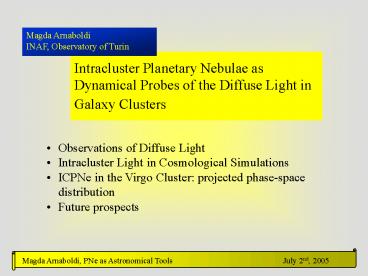Presentazione di PowerPoint - PowerPoint PPT Presentation
Title:
Presentazione di PowerPoint
Description:
Softening: 7.5 h-1. Box Size: 192 h-1 Mpc. CDM Concordance model ( 8=0.8) ... (Arnaboldi et al. 2003, ESO Messenger 112, 37) for the identification of ... – PowerPoint PPT presentation
Number of Views:21
Avg rating:3.0/5.0
Title: Presentazione di PowerPoint
1
- Observations of Diffuse Light
- Intracluster Light in Cosmological Simulations
- ICPNe in the Virgo Cluster projected phase-space
distribution - Future prospects
2
Observations of ICL in clusters
- 1951. Zwicky claimed the discovery of diffuse
light in the regions between galaxies belonging
to the Coma cluster. - 1971-1977. Follow-up photographic surveys for
diffuse light in Coma and rich clusters. - 1989-1995. CCD photometry of diffuse light. First
accurate measurements in Coma (Berstein et al.
1995).
- Problems
- typical surface brightness of the ICL is less
than 1 of sky brightness - it is difficult to disentangle between diffuse
light associated with the halo of the cD galaxy
at the cluster centre and the diffuse light
component
3
Measurements of ? in nearby clusters
4
Direct detections of IC stars
An alternative method for probing intracluster
light is through the direct detection and
measurements of the stars themselves
IC stars and gas in Virgo cluster
5
Importance of ICL in galaxy clusters
The ICL in cluster is relevant for the baryonic
fraction condensed in stars, star formation
efficiency, and the metal enrichment of ICM via
IC stars, especially in the cluster centre. It
contains a fossil record of galaxy evolution and
interactions in the cluster.
Merritt (1984) The ICL is removed from galaxies
early during the cluster collapse and its
distribution is predicted to follow closely that
of galaxies. ICL smoothly distributed and
dynamically old
Moore et al. (1996) the ICL is produced during
galaxy harassment and tidal stirring during late
infall. ICL still distributed in tails or plumes,
dynamically young.
6
Cosmological Simulations of Cluster Formation
from Springel et al. (2001)
- High-resolution resimulation of a part of a
Universe that collapes into a galaxy cluster.
Dark matter subhalos grow, fall into the cluster,
may survive or merge into larger halos. - same processes may act on stars in galaxies,
producing also ICL
7
Velocity distributions and projected phase space
diagrams for the IC stars
N. Napolitano et al. 2003, ApJ, 594, 172
8
Cosmological Hydrodynamic Simulations with Star
Formation and Feedback
- Studies of ICL in cosmological simulations
require a model of star formation from cold gas,
including cooling and feedback effects. Recent
studies are by Murante2004, Willman2004,
Sommer-Larsen2005. Here we use Gadget-2 with the
two-phase model of Springel Hernquist (2003). - Current hydrodynamic simulations have
significantly lower particle number than dark
matter only simulations. Thus they cannot resolve
small galaxies in clusters, probably causing
overestimate of predicted ICL fraction. Recent
high-resolution simulations obtain correct
half-mass radii for galaxies above few 1010M?.
The large galaxies contribute a substantial part
of the ICL this part can be studied. - Galaxies must be identified by a
substructure-finding algorithm here we use SKID
(Stadel 2001).
9
ICL in a Cosmological TreeSPH Simulation
Gadget-2 (V. Springel) Star Formation Cooling
(Z0) 2x4803 particles Mass ResolutionDM 4.6
109 h-1 M?Gas 6.9 108 h-1 M? Softening 7.5 h-1
Box Size 192 h-1 Mpc ?CDM Concordance model
(?80.8)
- We identified 117 clusters with Mgt1014 h-1M?
- Stars in clusters were divided in two classes
bound unbound. - we evaluated radial density profiles of the two
components
G. Murante et al. 2004, ApJ, 607, L83
10
Sersic fits
Galaxies ICL Sersic fit
ICL more centrally concentrated than galaxy light
(see also Zibetti et al. 2005)
11
ICL fractions, star ages
Murante et al. 2004 see also Sommer-Larsen et
al. 2005
12
High resolution cosmological simulations
Gadget-2 (V. Springel) Star Formation Cooling
(Z0) Feedback 1.5 106 particles in Cluster Mass
ResolutionDM 1.0 108 h-1 M?Gas 1.5 107 h-1
M? Softening 2.1 h-1 Mass 1.6 1014 h-1
M? Virial R 1.1 h-1 Mpc ?CDM Concordance model
(?80.8, h0.7)
Borgani et al. (2005)
13
Distribution of Dark Matter and Stars z3
z1
z0
14
Galaxies and Intracluster Stars z3
z1 z0
15
ICPNe in the Vigo cluster projected phase-space
distribution
- PNe trace light because the luminosity-specific
stellar death rate should be independent of the
precise state of the underlying stellar
population (Renzini Buzzoni 1986). - The OIII line emission at 5007Å is the
strongest emission from a PN it allows the
identification the measurement of its radial
velocity
16
Planetary Nebulae as tracers of cluster evolution
- ICPNe as light tracers
- Narrow band imaging surveys with large field
mosaic cameras (WFI_at_ESOMPI 2.2m tel.
SuprimeCam_at_SUBARU) - Developmenttests of selection criteria based on
photometric catalogs from Sextractor (Arnaboldi
et al. 2003, ESO Messenger 112, 37) for the
identification of the ICPNe associated with the
ICL (Arnaboldi et al. 1996, 2002, 2003 Okamura
et al. 2002 Feldmeier et al. 1998, 2002, 2003,
2004 Aguerri et al. 2005, AJ, 129, 2585).
- ICPNe as kinematical tracers
- Follow up studies aiming at measuring spectra
from multi-slit spectrograph (FORS2 _at_ ESO VLT
Gerhard et al. 2002, ApJ, 580, L121, Arnaboldi
et al. 2003, AJ, 125, 514) - First spectra from multi-fiber spectrograph for
a statistical significant sample of ICPN (FLAMES
_at_ ESO VLT Arnaboldi et al. 2004, ApJ, 614, L33
ESO PR 24/04)
17
(No Transcript)
18
- The ICPNe number density distribution in the
Virgo cluster is highly inhomogeneous - inhomogeneous distribution in single fields,
- field-to-field number density fluctuations.
19
Significant field-to-field variation of the ICL
in the Virgo cluster No clear number density
trend with distance from cluster center in M87
Mean surface luminosity density of ICL in Virgo
core 2.7 106 L?































